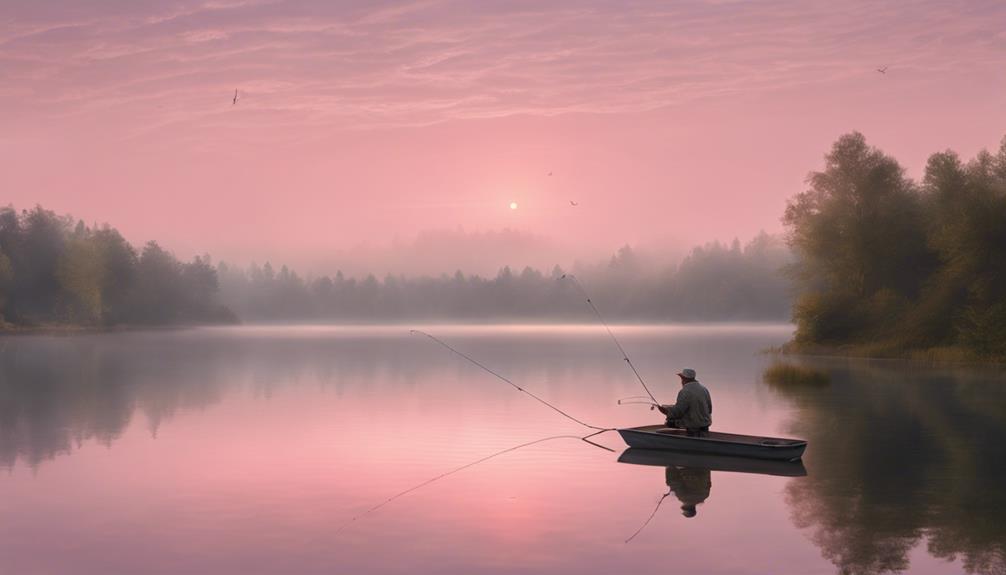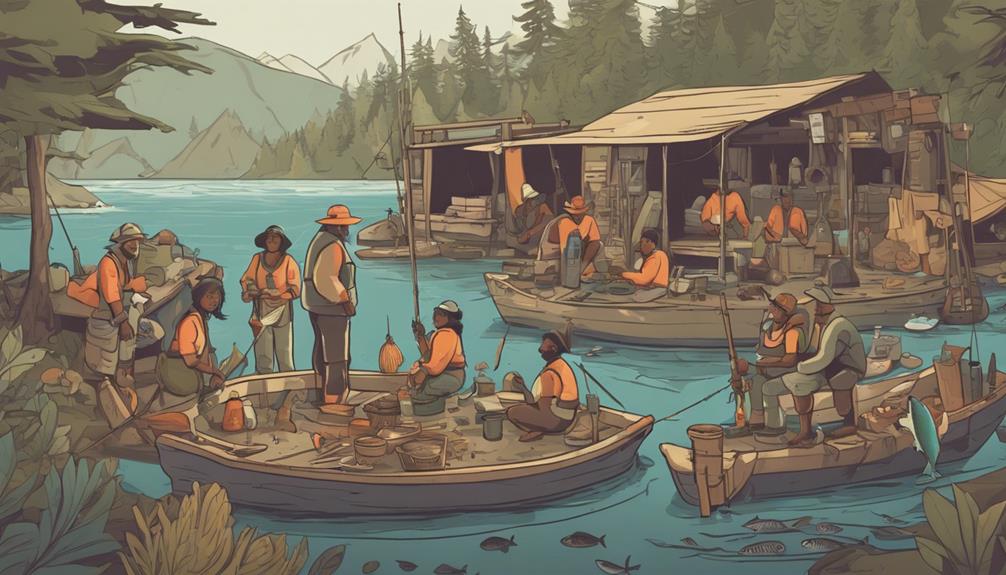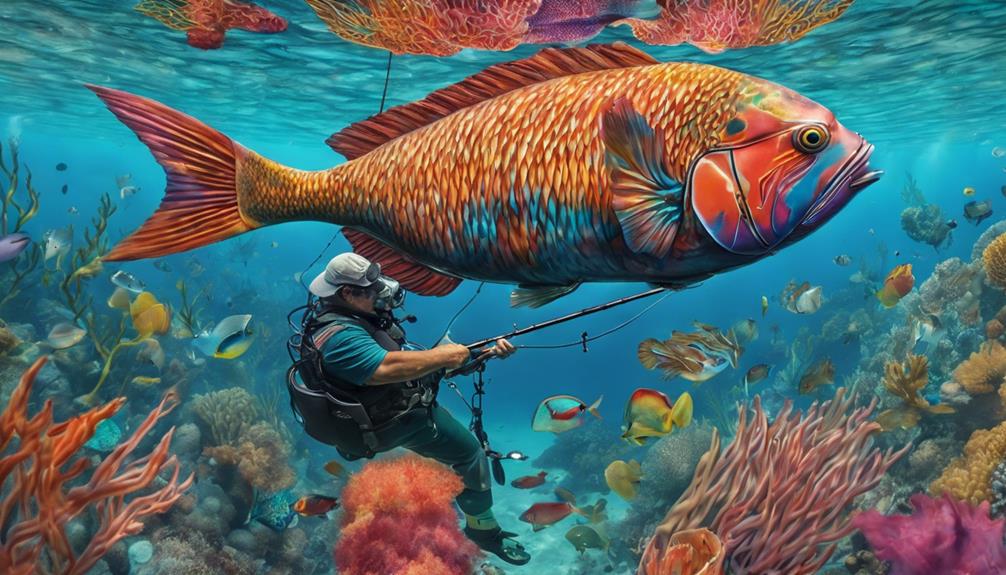Imagine reeling in a largemouth bass during the early morning hours when the mist is still hanging over the water. Now, picture yourself casting a line for rainbow trout as the sun begins to set behind the mountains.
Both scenarios offer unique experiences, but what if you could optimize your fishing trips even further by targeting specific species during their peak times? Explore the top 14 peak times for species-specific fishing to enhance your angling adventures and potentially increase your catch rate.
Best Times for Bass Fishing
To maximize your chances of catching bass, fish during the early morning or late evening when they're most active. Largemouth bass, known for their aggressive nature, are often found lurking near structures like weed beds, fallen trees, or docks. If you're targeting these feisty fish, try using topwater tactics such as buzz baits or poppers to entice them to strike. Smallmouth bass, on the other hand, prefer rocky areas and deeper waters. During the prime hours of dawn and dusk, these bronzebacks tend to be more active and willing to bite.
When fishing for largemouth bass, focus on shallow waters close to cover. Cast your topwater lures near these areas and use a steady retrieve to mimic the movement of prey on the surface. Largemouth bass are notorious for explosive strikes, so be prepared for an adrenaline-pumping battle once they take the bait.
For smallmouth bass, opt for lures like crankbaits or jerkbaits that can dive deeper into the water column where they typically feed. By presenting your bait at varying depths and speeds, you can trigger a reaction strike from these cunning fish. Remember, timing is crucial when targeting bass, so make the most of the early morning and late evening hours to reel in your trophy catch.
Prime Hours for Trout Fishing
During the peak hours of dawn and dusk, trout fishing tends to be most productive for anglers seeking a successful catch. Trout are known to be more active during these low light periods, making it an ideal time to try your luck at reeling in some of these elusive fish.
Here are some tips to make the most of your trout fishing experience:
- Use Fly Fishing Techniques: Trout are often enticed by the delicate presentation of flies on the water's surface. Mastering the art of fly fishing can significantly increase your chances of a successful trout catch during the prime hours of dawn and dusk.
- Target Trout Habitat Preferences: Trout are typically found in cool, clear streams or lakes with plenty of cover in the form of rocks, logs, and overhanging vegetation. During dawn and dusk, focus your efforts on areas where trout are likely to seek shelter and food, such as eddies, riffles, and deep pools.
- Experiment with Different Flies: Trout have varying preferences when it comes to food, so trying out different fly patterns can help you figure out what the trout in a particular area are biting on during these prime hours.
- Stay Stealthy: Trout have keen senses, especially in low light conditions. Move quietly along the water's edge, avoid making loud noises, and cast your line with precision to avoid spooking the trout during these crucial fishing hours.
Optimal Periods for Salmon Fishing
For successful salmon fishing, timing your outings to coincide with the peak migration periods can significantly boost your chances of a bountiful catch. When targeting salmon, understanding the impact of weather conditions and tidal movements is crucial for maximizing your fishing success.
Salmon fishing is often most productive during the cooler months when these fish are actively migrating. To optimize your chances, aim to fish during overcast days or when there's a light drizzle. These weather conditions can trigger salmon to be more active, increasing your likelihood of a successful catch. Additionally, monitoring tidal movements is essential, as salmon tend to follow the tides when moving towards their spawning grounds. Fishing during incoming or outgoing tides can lead to more bites, as the movement of water influences the salmon's behavior and feeding patterns.
When planning your salmon fishing trips, consider consulting tide charts and weather forecasts to align your outings with the most favorable conditions. By being mindful of weather conditions and tidal movements, you can enhance your fishing experience and increase the chances of reeling in a prized salmon.
Peak Seasons for Walleye Fishing
Understanding the peak seasons for walleye fishing is crucial for maximizing your chances of a successful catch. Walleye, known for their elusive nature, can be easier to target during specific times of the year. Here are some key points to keep in mind:
- Trophy Walleye: The best time to land a trophy walleye is typically during the spring and fall seasons when these fish are more active and tend to gather in shallower waters. Targeting trophy walleye during these peak seasons can significantly increase your chances of a memorable catch.
- Spring Jigging: Spring is an excellent time for walleye fishing, especially when using jigging techniques. As the water temperatures rise during the spring months, walleye become more active and move into shallower areas to feed. Jigging near structures like rocky points or underwater ledges can be particularly effective during this season.
- Summer Walleye: While walleye fishing can be a bit more challenging in the summer months due to increased boat traffic and warmer water temperatures, focusing on early morning or late evening fishing trips can still yield good results. Look for walleye in deeper waters or near underwater structures during the summer.
- Fall Feeding Frenzy: As the temperatures start to cool down in the fall, walleye go into a feeding frenzy to prepare for the upcoming winter months. This period offers excellent opportunities to catch walleye in abundance, especially in shallower waters close to drop-offs or submerged vegetation.
Ideal Moments for Crappie Fishing
Optimizing your crappie fishing success hinges on pinpointing the ideal moments for casting your line. When it comes to crappie fishing, night fishing can be particularly rewarding. Crappies are known to be more active during the night, especially in the warmer months when they move to shallow waters. To increase your chances of a successful night fishing excursion, consider using lighted bobbers or glow-in-the-dark lures to attract these elusive fish.
During the winter months, crappie behavior changes, requiring different techniques for a successful catch. Winter techniques for crappie fishing often involve slowing down your presentation. As the water temperature drops, crappies become less active and may be found in deeper waters. Using small jigs or live bait like minnows can entice sluggish crappies to bite. Additionally, fishing near structures such as brush piles or fallen trees where crappies seek shelter from the cold can improve your chances of a winter catch.
Top Times for Catfish Fishing
To maximize your success in catfish fishing, focus on targeting peak feeding times. Catfish are known to be more active during specific periods, and being aware of these times can significantly improve your chances of a successful fishing trip.
Here are the top times for catfish fishing:
- Night Fishing in Summer: Catfish are nocturnal feeders, and during the summer months, they tend to be more active at night. The cover of darkness gives them a sense of security, making them venture out to feed more freely. Consider using strong-smelling baits to attract them during these night fishing excursions.
- Early Morning in Winter: In contrast to summer, during the winter, catfish can often be more active in the early morning hours. The colder temperatures seem to prompt them to feed earlier in the day. Fishing for catfish in the early morning during winter months can yield great results.
- Dusk and Dawn: Catfish are also known to be active during the transitional periods of dusk and dawn. These low-light times are ideal for catfish feeding, as they feel more confident to leave their hiding spots and search for food.
- Before and After Storms: Changes in atmospheric pressure before and after storms can trigger catfish to feed more aggressively. Take advantage of these weather patterns to target catfish when they're most active.
Key Hours for Pike Fishing

For successful pike fishing, pinpointing the key hours when these predatory fish are most active is essential. Pike are known to be particularly active during the early morning and evening bites. In the early morning, pike are often feeding aggressively after a night of rest, making it an opportune time for anglers to target them. The low light conditions at dawn can also work in your favor, as pike are more comfortable and less cautious during these hours.
As the day progresses, pike tend to become less active, seeking shelter in weed beds or deeper waters. However, they pick up their activity levels again during the evening bites. This time frame is another prime opportunity to lure pike as they prepare for the night ahead. Keep in mind that pike have excellent low-light vision, giving them an advantage during dawn and dusk.
When it comes to nighttime pike fishing, employing the right strategies is crucial. Using noisy topwater lures can be effective, as pike rely heavily on their sense of hearing to locate prey in the dark. Additionally, fishing around structure and drop-offs where pike may be hunting can increase your chances of success. Remember to stay safe and bring appropriate lighting to navigate the waters during night fishing excursions.
Perfect Windows for Carp Fishing
Wondering when the perfect windows for carp fishing are? When it comes to targeting carp, timing is crucial for a successful fishing trip. By understanding the ideal conditions and moments for carp fishing, you can significantly increase your chances of landing a prized catch.
- Carp Baiting Techniques: Carp are known to be opportunistic feeders, making baiting an essential aspect of carp fishing. The best windows for carp fishing often coincide with their natural feeding times. Early morning and late afternoon are prime times as carp tend to be more active during these periods. Experiment with different baiting techniques such as using boilies, pellets, or particles to see what works best.
- Night Fishing: Carp are nocturnal creatures, and night fishing can be incredibly productive. The quiet and darkness of the night can lure carp out of their hiding spots. Set up your carp fishing rigs strategically near known carp hotspots and be prepared for some thrilling night-time action.
- Carp Fishing Rigs: Choosing the right carp fishing rig is essential for success. During the perfect windows for carp fishing, opt for rigs that offer good presentation and hooking efficiency. Adjust your rigs according to water temperature fluctuations to entice carp effectively.
- Water Temperature Fluctuations: Carp are sensitive to water temperature changes. Keep an eye on water temperature fluctuations as they can influence carp behavior. Warmer water temperatures often lead to increased carp activity, making it a favorable time for fishing.
Frequently Asked Questions
Are There Any Specific Tips or Techniques That Can Increase My Chances of Catching Bass During Their Peak Times?
When trying to catch bass during their peak times, focus on tackle selection and adapt to weather patterns. Opt for lures that mimic their prey and adjust based on weather changes.
Use fishing techniques that target bass behavior and pay attention to water temperature for optimal results.
How Do Different Weather Conditions Affect Trout Fishing During Prime Hours?
When fishing for trout during prime hours, weather plays a crucial role. Rainfall can impact their behavior, with increased activity during light rain. Temperature fluctuations may affect where they're in the water column.
Wind speed can make casting challenging, but it can also push food closer to the shore, attracting trout. Cloud cover can make them more active as they feel safer.
Consider these factors to optimize your trout fishing experience.
What Are the Best Locations to Target Salmon During Their Optimal Periods?
When aiming for salmon at their prime times, consider river vs. ocean spots for steelhead fishing and inshore vs. offshore choices for tarpon targeting. Optimal locations will vary based on species and your desired experience.
Rivers offer a unique charm for steelhead enthusiasts, while ocean waters might bring a different thrill.
Similarly, inshore tarpon fishing can be rewarding in its own way compared to the excitement of offshore pursuits.
Are There Any Special Bait or Lures That Are Particularly Effective for Walleye Fishing During Peak Seasons?
For walleye fishing during peak seasons, tackle selection is crucial. Opt for jigs, crankbaits, or live bait like minnows. Pay attention to water temperature; walleye prefer cooler waters.
Experiment with different depths and structures when fishing. Moon phases can also influence their activity, so try fishing during the new or full moon. By adjusting your bait choice and techniques based on these factors, you can improve your chances of a successful walleye catch.
How Can I Best Prepare for Crappie Fishing During Their Ideal Moments?
To prepare for crappie fishing during their ideal moments, focus on tackle selection and consider using live minnows or small jigs. Pay attention to weather patterns for optimal conditions. Ensure your boat setup includes a depth finder and trolling motor.
Manage your time effectively by arriving at the fishing spot early and being patient. By combining the right gear, weather awareness, boat setup, and time management, you'll increase your chances of a successful crappie fishing trip.
Conclusion
So, whether you're after bass, trout, salmon, walleye, crappie, catfish, pike, or carp, knowing the peak times for each species can significantly increase your chances of a successful fishing trip.
Make sure to plan your outings accordingly and take advantage of these optimal periods to reel in some impressive catches.
Remember, timing is key when it comes to species-specific fishing, so get out there and make the most of these top peak times!



